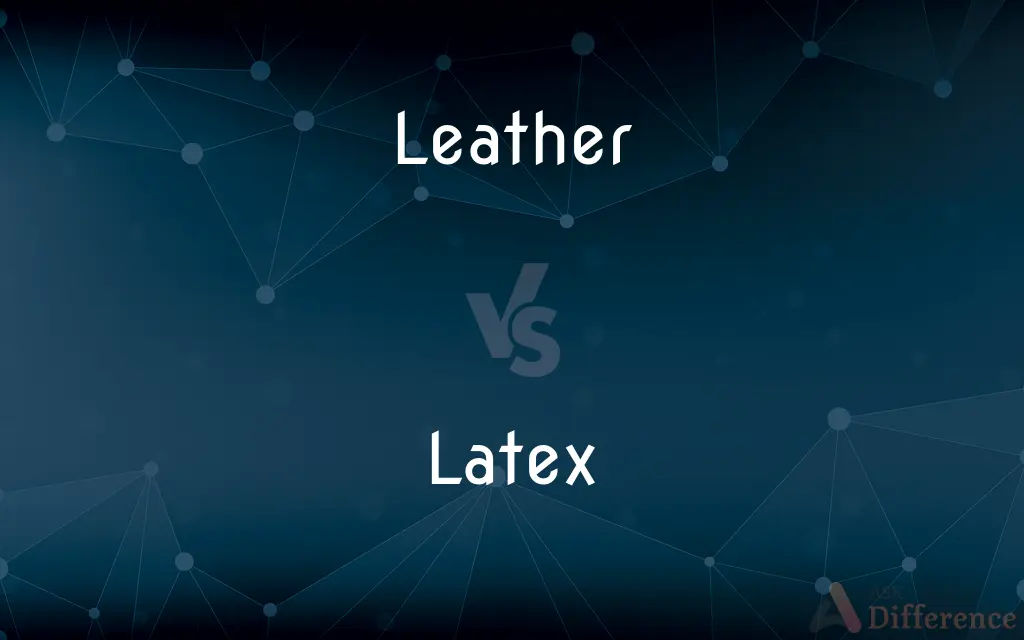Leather vs. Latex — What's the Difference?
By Maham Liaqat & Fiza Rafique — Updated on March 10, 2024
Leather is a durable material made from animal hides, known for its strength and natural look, whereas latex is a flexible, synthetic rubber, prized for its elasticity and smooth finish.

Difference Between Leather and Latex
Table of Contents
ADVERTISEMENT
Key Differences
Leather is derived from animal hides through a process called tanning, making it a natural, breathable material with unique textures. On the other hand, latex is produced either naturally from the sap of rubber trees or synthetically, resulting in a stretchy material widely used in clothing, medical supplies, and various industrial applications.
Leather ages well, developing a patina over time that enhances its appearance, whereas latex maintains its original form and texture but can degrade when exposed to light and oils.
Leather products are often considered luxury items, including jackets, furniture, and accessories, due to their durability and classic appeal. Meanwhile, latex finds extensive use in the fashion industry, especially in high-end fetish wear, as well as in practical items like gloves and balloons, due to its flexibility and water-resistant properties.
Leather requires regular maintenance, such as conditioning and waterproofing, to preserve its quality and longevity. In contrast, latex demands careful handling to avoid tears and is usually cleaned with mild soap and water.
Leather is less elastic compared to latex, making it suitable for items that require form stability. Conversely, latex's high elasticity makes it ideal for products that need to stretch and conform to shapes, such as medical devices and tight-fitting garments.
ADVERTISEMENT
Comparison Chart
Origin
Animal hides
Natural rubber or synthetic
Texture
Varies with type, generally textured
Smooth and uniform
Durability
High, ages well
Moderate, can degrade with light/oils
Use Cases
Luxury goods, furniture, accessories
Fashion wear, medical supplies, industrial applications
Maintenance
Requires conditioning and waterproofing
Cleans easily, sensitive to oils and light
Compare with Definitions
Leather
A material made from the hide of animals by tanning.
The leather jacket aged beautifully over the years.
Latex
Requires specific care to prevent degradation.
Avoid exposing latex clothes to direct sunlight to prevent damage.
Leather
Often considered a luxury material.
Designer leather handbags command high prices.
Latex
A natural or synthetic rubbery material.
The latex gloves were stretchy and fit snugly.
Leather
Durable and flexible, used in making furniture and clothing.
She preferred leather seats for their luxurious feel.
Latex
Used widely in medical and industrial applications for its elasticity.
Latex tubing is essential in many medical devices.
Leather
Requires regular care to maintain its appearance.
Conditioning the leather sofa kept it looking new.
Latex
Known for its smooth finish and stretchiness.
The latex dress hugged her contours perfectly.
Leather
Can develop a unique patina over time.
His leather wallet had a rich patina that added to its charm.
Latex
Can be found in both natural and synthetic forms.
Natural latex is harvested from rubber trees.
Leather
Leather is a strong, flexible and durable material obtained from the tanning, or chemical treatment, of animal skins and hides to prevent decay. The most common leathers come from cattle, sheep, goats, equine animals, buffalo, pigs and hogs, and aquatic animals such as seals and alligators.Leather can be used to make a variety of items, including clothing, footwear, handbags, furniture, tools and sports equipment, and lasts for decades.
Latex
Latex is a stable dispersion (emulsion) of polymer microparticles in water. Latexes are found in nature, but synthetic latexes are common as well.
Leather
A material made from the skin of an animal by tanning or a similar process
A leather jacket
Latex
A milky fluid found in many plants, such as poppies and spurges, which exudes when the plant is cut and coagulates on exposure to the air. The latex of the rubber tree is the chief source of natural rubber.
Leather
A piece of leather as a polishing cloth.
Latex
The colorless or milky sap of certain plants, such as the poinsettia or milkweed, that coagulates on exposure to air.
Leather
Short for stirrup leather
Latex
A polymer emulsion consisting of such sap obtained from rubber trees, used to manufacture various thin elastic products such as balloons, disposable gloves, and medical and contraceptive devices. Some people are allergic to this substance. Also called natural rubber latex.
Leather
Beat or thrash (someone)
He caught me and leathered me black and blue
Latex
A similar material made from polymers derived from petroleum; synthetic latex.
Leather
The dressed or tanned hide of an animal.
Latex
Latex paint.
Leather
Any of various articles or parts made of dressed or tanned hide, such as a boot or strap.
Latex
A clear liquid believed to be a component of a humour or other bodily fluid esp. plasma and lymph
Leather
The flap of a dog's ear.
Latex
The milky sap of several trees that coagulates on exposure to air; used to make rubber.
Leather
To cover wholly or in part with the dressed or tanned hide of an animal.
Latex
An emulsion of rubber in water, used in adhesives and the like.
Leather
(Informal) To beat with a strap made of hide.
Latex
(uncountable) Natural latex rubber, especially non-vulcanized rubber, such as is used in making latex gloves, latex condoms, and latex clothing.
Leather
Made of, relating to, or resembling dressed or tanned animal hide.
Latex
A milky or colored juice in certain plants in cavities (called latex cells or latex tubes). It contains the peculiar principles of the plants, whether aromatic, bitter, or acid, and in many instances yields caoutchouc upon coagulation. The lattex of the India rubber plant produces the rubber of commerce on coagulation.
Leather
A tough material produced from the skin of animals, by tanning or similar process, used e.g. for clothing.
Latex
Any aqueous emulsion of finely divided rubber or plastic particles, especially such an emulsion used as a base for paint; as, a latex paint.
Leather
A piece of the above used for polishing.
Latex
A milky exudate from certain plants that coagulates on exposure to air
Leather
(colloquial) A cricket ball or football.
Latex
A water-base paint having a latex binder
Leather
(plural: leathers) clothing made from the skin of animals, often worn by motorcycle riders.
Leather
(baseball) A good defensive play
Leather
(boxing) A punch.
Leather
The skin.
Leather
Made of leather.
Leather
(transitive) To cover with leather.
Leather
(transitive) To strike forcefully.
Leather
(transitive) To spank or beat with a leather belt or strap.
Leather
The skin of an animal, or some part of such skin, with the hair removed, and tanned, tawed, or otherwise dressed for use; also, dressed hides, collectively.
Leather
The skin.
Leather
To beat, as with a thong of leather.
Leather
Of, pertaining to or made of leather; consisting of leather; as, a black leather jacket.
Leather
An animal skin made smooth and flexible by removing the hair and then tanning
Common Curiosities
Can both leather and latex be used in clothing?
Yes, both materials are used in clothing, with leather being preferred for its durability and classic look, and latex for its elasticity and unique aesthetic.
How do you care for leather and latex items?
Leather requires conditioning and waterproofing, whereas latex needs to be cleaned with mild soap and water and protected from oils and light.
Is latex always synthetic?
No, latex can be either natural, derived from rubber tree sap, or synthetic.
What are the environmental impacts of producing leather and latex?
Leather production can have significant environmental impacts due to the chemicals used in tanning, whereas latex production impacts depend on whether it is natural or synthetic, with natural latex being more eco-friendly.
Why is leather considered a luxury material?
Leather is seen as luxurious due to its durability, natural origin, and the intricate process of tanning and crafting products from it.
Can latex degrade over time?
Yes, latex can degrade when exposed to light, oils, and certain chemicals.
What is leather made from?
Leather is made from the tanned hides of animals.
How is latex produced?
Latex can be produced naturally from rubber tree sap or synthetically.
Are leather products more expensive than latex products?
Generally, leather products are considered more luxurious and tend to be more expensive than latex products.
Is leather biodegradable?
Yes, leather is biodegradable due to its natural animal hide origin, but the process can be slow depending on the tanning methods used.
What is the main use of latex?
Latex is mainly used in medical supplies, clothing, and various industrial applications due to its elasticity and water-resistant properties.
Can latex be allergic to some people?
Yes, some individuals may have allergic reactions to natural rubber latex.
How does the texture of leather compare to latex?
Leather has a more varied texture, often textured and unique to each piece, while latex is smooth and uniform.
Are there vegan alternatives to leather?
Yes, there are vegan alternatives to leather, such as synthetic leathers made from polyurethane or other materials.
Is latex considered eco-friendly?
Natural latex is considered more eco-friendly compared to synthetic latex, but its environmental impact also depends on the harvesting and production processes.
Share Your Discovery

Previous Comparison
Acetate vs. Ethanoate
Next Comparison
Professional vs. ProfessionalismAuthor Spotlight
Written by
Maham LiaqatCo-written by
Fiza RafiqueFiza Rafique is a skilled content writer at AskDifference.com, where she meticulously refines and enhances written pieces. Drawing from her vast editorial expertise, Fiza ensures clarity, accuracy, and precision in every article. Passionate about language, she continually seeks to elevate the quality of content for readers worldwide.













































